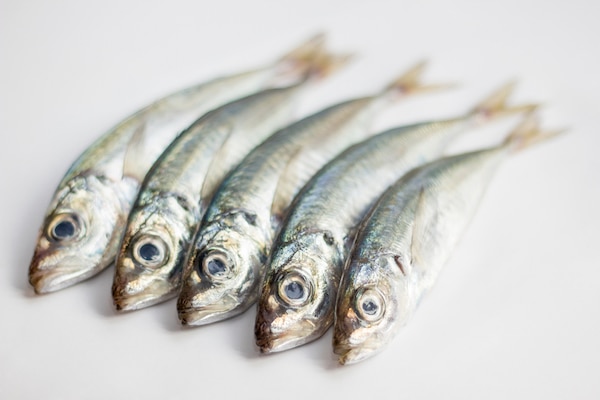Sardines for dogs? Yep, everyone in my animal house loves canned sardines. In fact, I’m not sure who loves them more— the dogs, the cats or me! I also appreciate the fact that you can buy sardines practically anywhere, at any time of the day or night. This is why I recommend stockpiling cans of sardines for dogs — and for other members of your household — in the event that a natural disaster strikes.

What nutrition do sardines offer for dogs?
So, why consider sardines for dogs? It’s rare when a treat this tasty and convenient is also packed with beneficial nutrients.
“Sardines may be small, but they’re mighty when it comes to pet nutrition,” says nutrition counselor Celia Kutcher, aka the Food Healer. Actually, this fish’s petite size is a big plus. “Since sardines are small, they tend to have far less mercury than larger fish, which makes them an ideal choice for people, too.”
Here’s why sardines for dogs are healthy: “Sardines are full of omega-3 fatty acids and Coenzyme Q10 (CoQ10),” Kutcher says. “The fatty acids have many health benefits, like cancer prevention, reducing inflammation, and keeping the immune system strong. CoQ10 supports a healthy heart and circulation. The fatty acids also help brain development, which makes them good for puppies and kittens.”
CoQ10, aka Ubiquinol, is also excellent for preventing dental disease in canines, felines and humans.
Some words of caution
One caveat when we’re talking sardines for dogs: Skip sardines slathered in sauce — such as oil, mustard or ketchup — and check the ingredient panel for the lowest-sodium specimens available.
“When buying sardines, make sure to always buy wild-caught, packed in water,” Kutcher cautions. “There’s no need for more oil, salt or any other ingredients — some of them could be harmful. Also, sardines should not be fed daily, as too much fish can form crystals in cats.”
What to know when it comes to serving sardines to dogs
Another thing to keep in mind when talking sardines for dogs — one small sardine contains about 25 calories and 175 mg of omega-3 fatty acids, which can be a pretty substantial treat for dogs. To cut back on the calories, cut sardines for dogs up into a few pieces. “If you have a larger pet, give them more proportionally,” she advises. “A cat can go with half a sardine. No worries about the bones, for dogs or cats — they’re safe, and will supply some calcium as well.” If you’re still worried about the bones, cutting the sardines into small pieces will help.
When you start giving your pets and new foods (like sardines), always start slowly and with a small amount. They should not cause stomach upset, but it’s better to be safe than have a sick pet.
“If you feed your pet too many sardines, they may develop a fishy smell,” says Kutcher. “If that’s the case, reduce the amount and frequency of feeding sardines.” You could also feed a loving spoonful of coconut oil as a chaser, to counteract that pungent, oceanic odor.
More fun facts about sardines for dogs
The water the sardines are packed in also makes an excellent, flavorful gravy for dog or cat food. No less a health authority than integrative medicine guru Dr. Andrew Weil pours sardine juice over his dogs’ kibble. My dogs love it when I soup up their kibble with sardine juice, plus a dash or two of turmeric, which has its own lovely health benefits.
Sardine juice is also great for masking the unpalatable smell of hard-to-swallow medications, Kutcher adds: “If you need to pill your pet, you can crush up the tablets and mix it with the liquid. That usually works.”
Tell us: Sardines for dogs: have you ever fed them to your pup? What was his reaction? Please share in the comments!
Read more about other human foods for dogs:
- Can Dogs Eat Onions? If Your Dog Ate Onions, What Do You Do?
- So, Your Dog Ate a Chicken Bone — Here’s What to Do
- Can Dogs Eat Mushrooms? What to Know About Dogs and Mushrooms
Featured Image Credit: chendongshan | Thinkstock.





